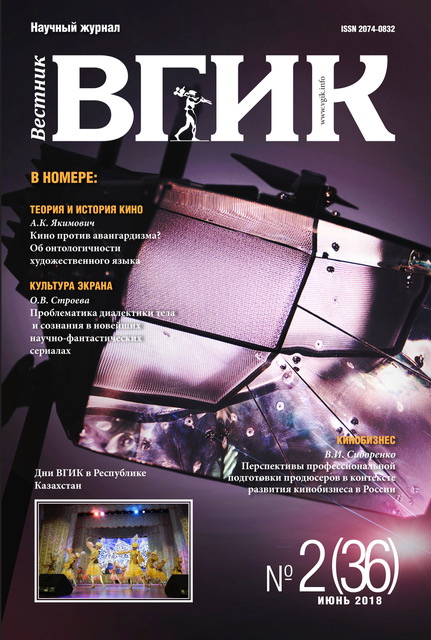The Product of Film Industry - a Cultural Good in Commodity Form
- Authors: Zhabsky M.I1
-
Affiliations:
- S. A. Gerasimov's Russian State Institute of Cinematography
- Issue: Vol 10, No 2 (2018)
- Pages: 27-36
- Section: THEORY AND HISTORY OF CINEMA | AUDIOVISUAL ARTS
- URL: https://journals.eco-vector.com/2074-0832/article/view/14572
- DOI: https://doi.org/10.17816/VGIK10227-36
- ID: 14572
Cite item
Full Text
Abstract
In consideration are the essence characteristics of a theatrical feature as a product of film industry. The focus of attention is a contradiction between the psychic-cultural use value of film-industry products and the commodity form of their production and consumption. As the object of spectatorship needs, the product of film industry distinguishes itself in the capacity of a story narrated in the language of cinema, interestingly to the targeted movie-goer. Spectatorship needs are emotional, intellectual and other psychic impetuses of the individual, requiring satisfaction through one’s immersion in the image world of cinema. A difference is drawn between the spectators’ needs toward cinema and those of society as a whole. The film production aimed at a profitable satisfaction of individual needs is incapable of explicating and meeting certain societal needs. Psychological mechanisms of immersing spectators in a film world are the processes of empathy and identification, regression and projection, imparting cinema with some sort of magic. The modern film industry has grown on the soil of commodity film production to which some essential demerits are endemic. Picture of the world created by it is a function of the film’s commodity form, thus rendering the picture mongrel in many respects. The magnitude of the box office, functioning as a code for establishing and maintaining interaction between the society’s cultural “highs” and “lows”, entails certain dysfunctional consequences. In the modern conditions of globalization the national commodity-film production is forced to adapt to the demands of Americanized mass audience. With the irreversibility of an objective law, there crops up a certain loss of the national production’s own face. In this regard, consideration is given to the issues of authentically expressing and reproducing the nation’s identity by the means of cinema.
Full Text
Abstract: In consideration are the essential characteristics of a theatrical feature as a product of the film industry. The focus of attention is a contradiction between the psychic-cultural use-value of film-industry products and the commodity form of their production and consumption. As the object of spectatorship needs, the product of film industry distinguishes itself in the capacity of a story narrated in the language of cinema, interestingly to the targeted movie-goer. Spectatorship needs are emotional, intellectual and other psychic impetuses of the individual, requiring satisfaction through one’s immersion in the image world of cinema. A difference is drawn between the spectators’ needs toward cinema and those of society as a whole.
The film production aimed at a profitable satisfaction of individual needs is incapable of explicating and meeting certain societal needs. Psychological mechanisms of immersing spectators in a film world are the processes of empathy and identification, regression and projection, imparting cinema with some sort of magic. The modern film industry has grown on the soil of commodity film production to which some essential demerits are endemic. Picture of the world created by it is a function of the film’s commodity form, thus rendering the picture mongrel in many respects. The magnitude of the box office, functioning as a code for establishing and maintaining interaction between the society’s cultural “highs” and “lows”, entails certain dysfunctional consequences. In the modern conditions of globalization, the national commodity-film production is forced to adapt to the demands of Americanized mass audiences. With the irreversibility of objective law, there crops up a certain loss of the national production’s own face. In this regard, consideration is given to the issues of authentically expressing and reproducing the nation’s identity by the means of cinema.
About the authors
Mikhail I Zhabsky
S. A. Gerasimov's Russian State Institute of Cinematography
Author for correspondence.
Email: m.zhabsky@gmail.com
Doctor in Sociology, Head of the Sociology Sector, Institute of Film Art, VGIK
Russian Federation, MoscowReferences
- Конвенция об охране и поощрении разнообразия форм культурного самовыражения // URL.: http://www.ifapcom.ru/files/Konventsiya_ob_ohrane_i_pooschrenii_raznoobraziya_ form_kul_turnogo_samovyrazheniya.pdf
- Жабский М.И. Социокультурная драма кинематографа. Аналитическая летопись (1969-2005). - М., 2009. - 774 с.
- Маркс К. Капитал. Критика политической экономии. Т. I. Кн. 1. Процесс производства капитала. - М.: Политиздат, 1983. - 905 c.
- Тарасов К.А. Насилие в фильмах: три условия миметического воздействия // Вестник ВГИК, 2016, № 2 (28). - С. 84-96.
- Тарасов К.А. Насилие в кино: латентное воздействие // ПОИСК: Политика. Обществоведение. Искусство. Социология. Культура, 2017. № 1 (60). - С. 107-118.
- Bächlin P. Film als Ware / Materialien zur Theorie des Films. Aesthetik, Soziologie, Politik. - München. 1971. - S. 146-157.
- Baron R.A., Byrne D. Social Psychology: Understanding Human Interaction. 5th Edition. - Toronto: Allyn and Bacon, Inc., 1987. - 630 p.
- Mirror neuron. From Wikipedia, the free encyclopedia // URL.: https://en.wikipedia.org/ wiki/Mirror_neuron (дата обращения: 27.01.2018)
Supplementary files








